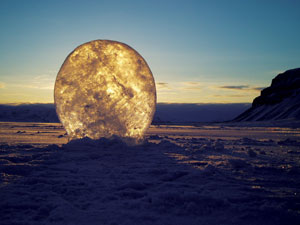
Climate Change and the Humanities: A Case for the Arts

Ice Lens, Heather Ackroyd & Dan Harvey.
Part of the 2005 Cape Farewell Project.
Poets, writers, artists, and photographers who have engaged with global warming believe that the arts are an essential part of creating the large-scale public awareness and understanding of climate change that can bring about substantive policy change. Diverse academics have investigated this view in recent years. The effects of art and photography on climate change may be quite significant. Not only in galleries and museums, but almost everywhere in media, words are ceding space to images. Throughout newspapers, magazines, and institutional publications, perceptions and framing of issues happen increasingly through images. Art and literature can reveal major changes to the landscape occurring throughout the country as global warming progresses. They challenge the standard human/environment narrative, in which humans are both privileged and separate from nature, and show how individuals and communities who are marginalized within the larger climate change debate seek to change the conversation.
Artists have proposed new images and representations of global warming in myriad forms. Artists, writers, and poets are working in a wide array of art forms, including painting, sculpture, poetry, documentaries, photo-essays, photography exhibits, and innovative techniques. Cutting edge works include those of Olafur Eliasson. At a San Francisco Museum of Modern Art exhibition in the fall of 2007, visitors could don a grey blanket and enter a room kept at exactly ten degrees Fahrenheit to see Eliasson’s “ice car,” a BMW hydrogen-powered racing car covered in a thick coat of ice. Eliasson, touted as “cutting edge” by the international art world, hopes his “ice car” will spur thinking on the relation between car design and climate change. Like many climate change artists, Eliasson uses art to create environmental awareness by engaging and prompting the public to acknowledge responsibility and foster social change. He hopes his work will inspire more responsible public behavior. He states, “What I find so interesting in this research on movement and environmentally sustainable energy is the fact that it enhances our sense of responsibility regarding how we navigate as individuals in our shared, complex and polyphonic world.”
The Cape Farewell Project leads Arctic expeditions with artists, scientists, and journalists, in hopes of increasing environmental awareness and engaging the public and schools in more fruitful debates about climate change. Project founder David Buckland believes in the power of art in helping to bring about policy change. “One salient image, sculpture or event,” says Buckland, “can speak louder than volumes of scientific data and engage the public’s imagination in an immediate way.”
Similarly, journalist Alex Morrison said of an exhibit traveling the world from 2007 through 2008, Envisioning Change, which chronicles the effects of climate change on diverse global regions such as the Polar Regions, the Andes and the Himalayas: “The beautiful, thought-provoking, and sometimes shocking images engage viewers on an emotional level that can’t be achieved through words alone.” The goal is to increase awareness of the effects of climate change on the world’s coldest regions and to inspire changes in behavior that can slow it down.
There is also a rich history of landscape art in the United States, as well as the art and literature of naturalists such as John James Audubon; romantic philosophers such as Ralph Waldo Emerson and Henry David Thoreau; and nature poets, such as Walt Whitman, Robert Frost, and today’s Gary Snyder and Robert Hass. Indeed, many of the prominent figures in the environmental humanities were deeply influenced by nature and America’s rich natural aesthetics. Aldo Leopold was a naturalist, ecologist, and farmer, as well as a “green” philosopher. Annie Dillard grew up in the wilds of Pennsylvania’s rivers and forests. And writers such as John McPhee and Barbara Kingsolver find their inspiration in the remains of American “wilderness.”
Increasingly, with most individuals living in cities, fewer scholars enjoy childhoods or even summers in the wilderness. In cities that are increasingly urban, art remains one of the best ways to educate large numbers of Americans about the rich heritage of wilderness aesthetics that played such a large role in fueling environmental movements, from the parks movements of the early twentieth century, to the sweeping legal changes of the 1970s, to the climate change movement today. Rapid changes taking place in parks and forests are a vital spark for the climate change movement today. To name just one poignant example, Glacier National Park is facing the declassification of a large number of its glaciers.
Images could play a formative role in changing personal behavior and public policy. Viewing art or reading poetry could help to promote individual and collective action, even when the consequences of climate change seem distant in place and time. Climate change may be directly experienced as a few hot days or connected to a powerful hurricane, but that awareness could be used to stimulate behavioral changes over longer time frames. Thus, viewing spectacular canvasses such as those of the American West by Albert Bierstadt and Thomas Moran, reading compelling novels such as John Steinbeck’s Grapes of Wrath that portray the consequences of climate on the Great Plains, or seeing a powerful film such as Al Gore’s “An Inconvenient Truth,” can indeed inspire social change.
*Excerpt from “Melting Ice: Climate Change and the Humanities,” a lecture delivered at the University of Illinois at Urbana-Champaign, August 2009.
Carolyn Merchant is a professor in Environmental Science, Policy & Management at UC Berkeley.
Click here for the complete, published article.
This article can be found in the February/March 2010 newsletter.